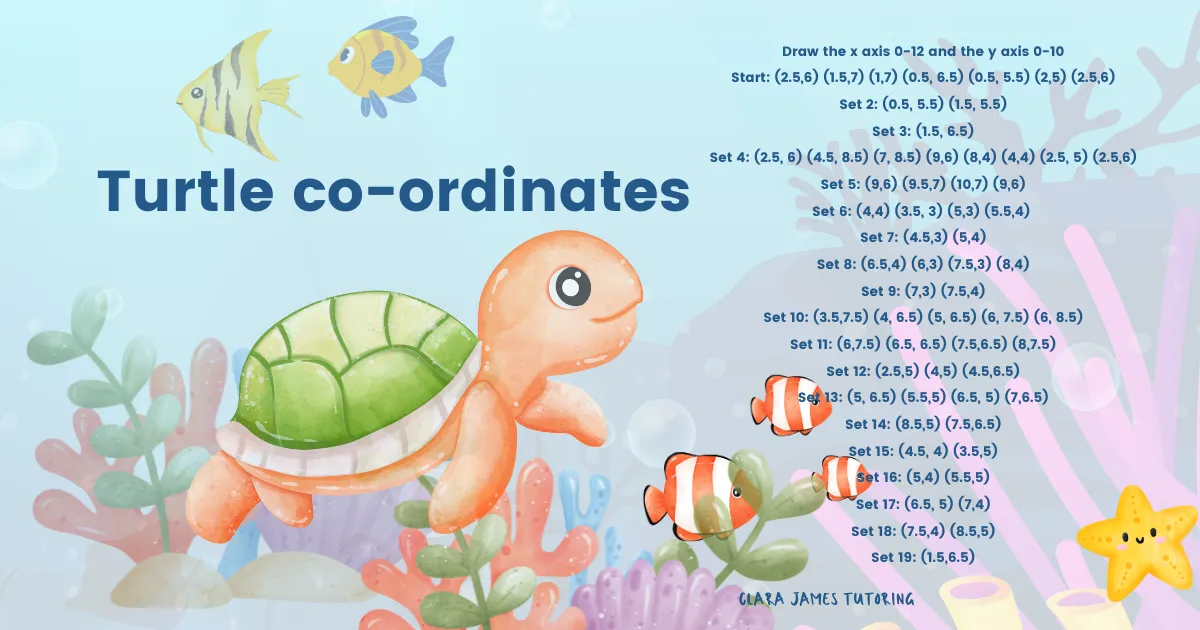Clara James Tutoring
BLOG POSTS

Creating Creatures with Co-ordinates
To plot the co-ordinates, take the first number, that tells you have far to across you go. The second number tells you how far up to go. We were taught: along the corridor and up the stairs.
The other day I created a couple of co-ordinates images for the 11+ course, which I thought I’d share since it’s the end of term, I thought I’d do something a bit more creative.

To plot the co-ordinates, take the first number, that tells you have far to across you go. The second number tells you how far up to go. We were taught: along the corridor and up the stairs.
Once you get to that point draw a little dot. Next, repeat the steps and plot the second point. Now join these 2 points up. Continue each section until you completed the image. Then you can colour it in if you choose.
I apologise my drawing skills are not my strong point, but I hope the shapes (a turtle and an elephant) are recognisable and you enjoy the task regardless.
Elephant co-ordinates
Draw the axis 0-12 for both the x and the y
Start (4,5) (4,7) (4.5, 8) (5,7) (5,6) (4,5)
Set 2 (5,7) (6,8) (6,10) (6.5,10) (6.5,8) (7.5,7) (6.5, 5) (6,5) (5,6)
Set 3 (7.5,7) (8,8) (8.5,7) (8.5,8) (7.5,6)
Set 4 (6,5) (4.5, 4) (4.5,1) (6,1) (6, 2.5) (6.5, 2.5) (6.5,1) (8,1) (8,4) (6.5,5)
Set 5 (6,3) (6.5,3) (6.25,3.5) (6.25,4) (6.25, 3.5) (6,3)
Set 6 (6,7)
Set 7 (6.5, 7)
Turtle co-ordinates
Draw the x axis 0-12 and the y axis 0-10
Start: (2.5,6) (1.5,7) (1,7) (0.5, 6.5) (0.5, 5.5) (2,5) (2.5,6)
Set 2: (0.5, 5.5) (1.5, 5.5)
Set 3: (1.5, 6.5)
Set 4: (2.5, 6) (4.5, 8.5) (7, 8.5) (9,6) (8,4) (4,4) (2.5, 5) (2.5,6)
Set 5: (9,6) (9.5,7) (10,7) (9,6)
Set 6: (4,4) (3.5, 3) (5,3) (5.5,4)
Set 7: (4.5,3) (5,4)
Set 8: (6.5,4) (6,3) (7.5,3) (8,4)
Set 9: (7,3) (7.5,4)
Set 10: (3.5,7.5) (4, 6.5) (5, 6.5) (6, 7.5) (6, 8.5)
Set 11: (6,7.5) (6.5, 6.5) (7.5,6.5) (8,7.5)
Set 12: (2.5,5) (4,5) (4.5,6.5)
Set 13: (5, 6.5) (5.5,5) (6.5, 5) (7,6.5)
Set 14: (8.5,5) (7.5,6.5)
Set 15: (4.5, 4) (3.5,5)
Set 16: (5,4) (5.5,5)
Set 17: (6.5, 5) (7,4)
Set 18: (7.5,4) (8.5,5)
Set 19: (1.5,6.5)
(If you do have a go, I'd love to see what you create)
Our goal at Clara James Tutoring is to make learning fun and accessible to everyone. If children are engaged in what they are doing they are more likely to want to participate, if they are enjoying it, they are more likely to relax and retain the information.
If they are retaining the information it will help boost their knowledge and with knowledge comes confidence.
If you have a child who enjoys learning through games and being more creative, and you enjoy spending time with them, you might be interested in the Clara James Approach, the membership group we have put together to support you in supporting your primary school aged child with their maths and English.
Interested?
Click here to learn more: The Clara James Approach
Morning,
I hope the week is going well.
So many people seem to be doing D of E and work experience
at the moment, good luck if that’s you and if you’re at Marlow Camp next
fingers crossed for good weather!
I’ve just finished a lesson on division. It seems to be
something that messes with the brains of so many people.
I found it got easier when I stopped thinking about it as
division and instead thought about it as multiplication. So, if for example I
had the question 396 divided by 3, I would look at it as 3x what = 3. My answer
would be 1. How many times would I need to multiply 3 to get to 9, (my answer
would be 3). Then 3x something = 6. My answer would be 2. Giving me the overall
answer of 132.
I know that’s a really simple example but hopefully it explains
my point.
Thankfully in schools they don’t often seem to need to do
long division, but I’ve worked with a couple of adults (generally nurses for
some reason) who have needed it.
I think I’ll explain this one in a video, as it will be too
complicated to explain it with words as bits get put all over the place. I hope
this makes sense though:
Enjoy the rest of the week and speak soon,
Dawn

